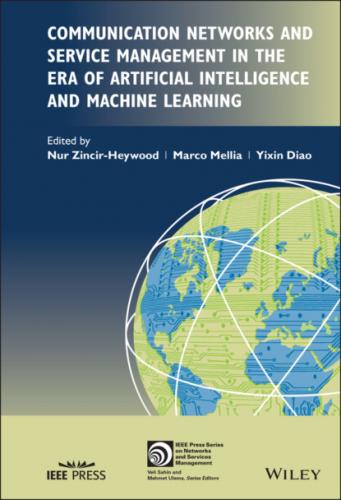Chapter 11, The New Abnormal: Network Anomalies in the AI Era, summarizes recent developments on how AI algorithms bring new possibilities for anomaly detection, and discusses new representation learning techniques such as Generative Artificial Networks and Autoencoders, and new techniques such as reinforcement learning that can be used to improve models learned with machine learning algorithms.
Chapter 12, Automated Orchestration of Security Chains Driven by Process Learning, describes an automated orchestration methodology for security chains in order to secure connected devices and their applications and illustrates how it could be used for protecting Android devices by relying on software‐defined networks.
Chapter 13, Architectures for Blockchain‐IoT Integration, focuses on defining and determining measures and criteria to be met for an efficient Blockchain and Internet‐of‐Things integration. It discusses the integration incentives and suitable use cases, as well as the dedicated metrics for scalability, security, and energy efficiency.
New York
Nur Zincir‐Heywood
Marco Mellia
Yixin Diao
Acknowledgments
We sincerely thank all authors for their contributions. This book would not have been possible without their support and sharing of long‐time expertise to benefit the broader audience of this book. We are especially thankful to our Book Series Editors Dr. Mehmet Ulema and Dr. Veli Sahin for inspiring us to start this book project and for providing enthusiastic support throughout. Last but certainly not least, we want to express our sincere gratitude to IEEE – Wiley editors Mary Hatcher, Teresa Netzler, and Victoria Bradshaw for their countless effort to make this book become a reality.
Acronyms
5GFifth generation standard for broadband cellular networks6GSixth generation standard for broadband cellular networksADAdministrative DomainAEAuto EncoderAFApplication FunctionAIArtificial IntelligenceANNArtificial Neural NetworksAPIApplication Programming InterfaceAPAccess PointARQAutomatic Repeat reQuestASAutonomous SystemASICApplication‐Specific Integrated CircuitAWSAmazon Web ServicesBCBlockchainBGPBorder Gateway ProtocolBNGBroadband Network GatewayC/SClient‐ServerCNNConvolutional Neural NetworksCDNContent Distribution NetworkConvLSTMConvolutional Long‐Short Term MemoryCQIChannel Quality IndicatorD2DDevice‐to‐DeviceDAGDirected Acyclic GraphsDASHDynamic Adaptive Streaming over HTTPDCData CenterDDoSDistributed Denial‐of‐ServiceDLDeep LearningDLTDistributed Ledger TechnologyDNNDeep Neural NetworkE2EEnd‐to‐EndEMEnforcement ModuleFCFog ComputingGBMGradient Boosting MachineGCNGraph Convolutional NetworkGNNGraph Neural NetworkGPGaussian ProcessGUIGraphical User InterfaceHDFSHadoop Distributed File SystemHetNetsHeterogeneous NetworksIAMIdentity and Access ManagementILPInteger Linear ProgrammingIoTInternet of ThingskNNK‐Nearest NeighborsKPIKey Performance IndicatorLoRaWANLong‐Range Wide‐Area NetworkLP‐WANLow‐Power Wide Area NetworkLSTMLong‐Short Term MemoryMACMedia Access ControlMANOManagement and OrchestrationMDPMarkov Decision ProcessMECMulti‐access Edge ComputingMIBManagement Information BaseMILPMixed‐Integer Linear ProgrammingMINLPMixed Integer Nonlinear Programming ProblemsMLMachine LearningMLPMultilayer PerceptronMMMonitor ModulemMTCMassive Machine Type CommunicationsmmWaveMillimeter WaveMNOMobile Network OperatorMOSMean Opinion ScoreMPLSMultiprotocol Label SwitchingMSEMean Squared ErrorMTUMaximum Transmission UnitNFVNetwork Function VirtualizationNFVINetwork Function Virtualization InfrastructureNFVONetwork Function Virtualization OrchestratorNICNetwork Interface ControllerNNNeural NetworkNOCNetwork Operation CenterONFOpen Networking FoundationOTNOptical Transport NetworkOTSOptical Transport SectionP2PPeer‐to‐PeerPKPublic KeyPoPPoint of PresenceQCQuantum ComputingQoEQuality of ExperienceQoSQuality of ServiceRANRadio Access NetworkRAPRadio Access PointRDDResilient Distributed DatasetRIPRouting Information ProtocolRLReinforcement LearningRNNRecurrent Neural NetworkRRMRadio Resource ManagementRTTRound Trip TimeSCSmart ContractSDNSoftware Defined NetworkingSFCService Function Chaining (updated in regards to Service Function Chain)SINRSignal‐to‐Interference‐Plus‐Noise RatioSJFShortest Job FirstSLAService Level AgreementSNMPSimple Network Management ProtocolSNRSignal‐to‐Noise RatioSVMSupport Vector MachineSVRSupport Vector RegressionTOTraffic OptimizationTPSTransaction Per SecondTSPTraveling Salesman ProblemV2IVehicle to InfrastructureV2VVehicle to VehiclevBSVirtual Base StationVMVirtual MachineVMOVirtual Mobile OperatorVNEVirtual Network EmbeddingVNFVirtual Network FunctionWANWide Area NetworkWLANWireless Local Area NetworkWNWireless Nodes
1 Overview of Network and Service Management
Marco Mellia1, Nur Zincir‐Heywood2, and Yixin Diao3
1 Department of Electronics and Telecommunications, Politecnico di Torino, Torino, Italy
2 Faculty of Computer Science, Dalhousie University, Halifax, Nova Scotia, Canada
3 PebblePost, New York, NY, USA
1.1 Network and Service Management at Large
Nowadays the network, i.e. the Internet, has become a fundamental instrument to effectively support high value solutions that involve our daily life. Born to carry mainly data, today we use the Internet to watch high‐definition videos, conduct video conferences, stay informed, participate in social networks, play games, buy goods, and do business. All these value‐added services call for maintaining superior network service levels – where service disruption is not tolerated, and the quality of the service must be guaranteed. As a result of the many impacts of digitalization, the Internet has become increasingly complex and difficult to manage, with mobile broadband access networks able to connect billions of users at hundreds of megabit per seconds, backbone networks extending for thousands of kilometers with multi terabit per second channels, and huge datacenters hosting hundreds of thousands of servers, virtual machines, and applications.
The need for network and service management raised together with the first network concepts, with fundamentals that were defined within the International Organization for Standardization's Open Systems Interconnection (ISO/OSI) reference model [1, 2]. Telephone networks started moving to digital services in the 1970s, which created the need to manage these services automatically [3]. Computer communication technology radically changed the networking paradigm, with Transmission Control Protocol/Internet Protocol (TCP/IP) leading to the birth of the Internet as we know it today. Originally, computer network management was mostly a manual activity, in which the network administrator knew the configuration by hearth of each device and was able to quickly intervene in case of problems. Nowadays, with networks of billions of devices, millions of nodes, thousands of applications, network and service management has evolved to be as much as possibly automated. The advances with centralized and distributed approaches have enabled the Network Operation Center (NOC) to visualize and control the network in an as much as possible automatic fashion. Today, with the abilities to collect and process large amount of data, network and service management is facing a new stimulus toward the complete automation, with machine learning and artificial intelligence approaches that start being deployed in operations.
Network and service management fundamentally implements a control loop in which data about the status of the network is collected to be then processed in a centralized or distributed fashion to detect changes, with the goal to define which actions to implement, react, and control the changes.
